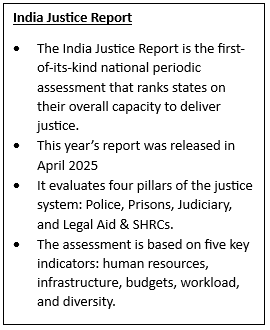SYLLABUS
GS-2: Welfare schemes for vulnerable sections of the population by the Centre and States and the performance of these schemes; mechanisms, laws, institutions and Bodies constituted for the protection and betterment of these vulnerable sections
GS-2: Government policies and interventions for development in various sectors and issues arising out of their design and implementation
Context: The India Justice Report’s recent study, “Juvenile Justice and Children in Conflict with the Law: A Study of Capacity at the Frontlines,” highlights that more than 50% pending cases are before the Justice Juvenile Board.
Key Findings of the Study

- High Pendency of Cases: As of 31 October 2023, India’s 362 Juvenile Justice Boards (JJBs) were handling 100,904 pending cases, with more than 55% unresolved.
- State-Level Disparities: Pendency varies sharply across states: Odisha reports an 83% pendency rate, while Karnataka stands at 35%, still indicating significant delays.
- Alignment with National Crime Data: The study’s findings echo NCRB’s Crime in India 2023 report, which recorded 40,036 juveniles apprehended in 31,365 cases, with nearly 75% aged 16–18 the group most vulnerable to criminalisation and weak rehabilitation systems.
Structural Gaps
- Large number of vacancies in Juvenile Justice Boards (JJBs): The study found that 24% of JJBs were functioning without a full bench. Of the 470 boards surveyed, 111 were not fully constituted, and only Odisha, Sikkim, and Jammu & Kashmir had complete benches in every district.
- Infrastructural Gaps: Fourteen states, including Andhra Pradesh, Maharashtra and West Bengal, do not have the mandated Places of Safety for 16–18-year-olds accused of heinous offences.
- Weak legal aid access: 30% of JJBs reported having no legal services clinic, despite the mandatory requirement.
• Lack of medical care and oversight:
- Inside Child Care Institutions (CCIs), there is a crisis of support staff shortage. In 15 states that provided data, nearly 80% of institutions reported having no medical staff or doctors.
- JJBs must inspect CCIs monthly, but data from 14 states and J&K show that only 810 inspections were done instead of the required 1,992.
• Lack of Data Transparency: There is no centralised public database for juvenile cases like the National Judicial Data Grid for adults, so the IJR had to file over 250 RTI applications across 28 states and two union territories to collect the report’s data.
Way Ahead
- Ensure Fully Functional Juvenile Justice Boards: Every district must have a fully constituted JJB with both judicial members and social workers.
- Prioritise Rehabilitation Over Institutionalisation: Policy focus should shift toward rehabilitation through diversion programmes, probation, counselling, education, and skill development, ensuring that children in conflict with the law are reintegrated rather than institutionalised.
- Establish a Centralised Digital Case Management System: A unified digital platform is needed to track cases, improve transparency, and enable seamless coordination among police, JJBs, child welfare committees, legal aid authorities, and care institutions.
- Expand and Upgrade Child-Care Infrastructure: States must strengthen infrastructure by creating adequate Observation Homes, Special Homes, and Places of Safety to meet the needs of children requiring care, especially those accused of serious offences.

